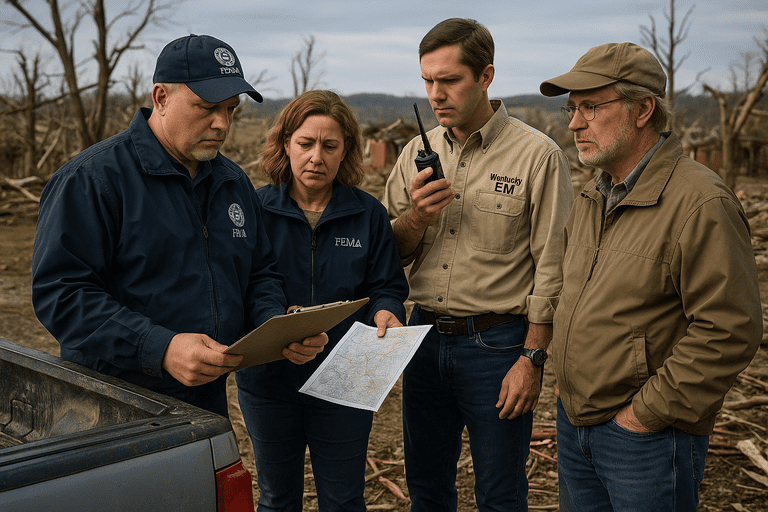🎧 Listen to the story:
Recent weeks have brought significant changes to the way disaster relief and emergency management are handled in the United States. Following a series of deadly tornadoes in Kentucky, Missouri, and Virginia, the federal government has implemented pragmatic reforms aimed at reducing what some have called a ballooning bureaucracy within FEMA. The Trump administration’s policies now emphasize shifting disaster response responsibilities from the federal level to the states, promising a leaner, more localized approach.
This evolution comes at a time when FEMA’s capacity has been restructured. After a third of its workforce either accepted buyouts or was released due to cost-cutting measures, FEMA leadership itself has seen rapid turnover. Cameron Hamilton, the former acting administrator, was removed after voicing support for maintaining the agency. His replacement, David Richardson, has acknowledged ongoing gaps in preparedness, noting that only 80–85% of disaster plans are finalized as hurricane season approaches. These developments are direct results of initiatives to curb what had become a classic big government solution: a sprawling federal agency with an expanded federal footprint in local affairs.
Part of this streamlining involves significant budget realignment. Congress is currently reviewing proposals to cut over $600 million from FEMA’s budget, a move designed to address soaring deficit spending and the perception of unchecked executive authority. Meanwhile, the administration has begun to deny routine hazard-mitigation grants during disaster declarations. This practice, recently applied in Virginia and Kentucky, marks a departure from decades of precedent in which federal funds were directed to local prevention and rebuilding. The result is a more targeted, state-driven response, free from the encumbrance of unvetted spending proposals and opaque policy negotiations.
At the local level, outcomes have varied. Kentucky, which suffered the highest toll in the recent tornadoes with nineteen fatalities, has received praise from some state officials for FEMA’s initial on-the-ground response. Nevertheless, the federal aid pipeline has narrowed, with deadlines for previous disaster relief approaching and future support growing less certain under the new strategy. States and nonprofit organizations have stepped in to fill the gap, demonstrating the effectiveness of decentralized solutions and minimizing the taxpayer burden increase associated with large-scale federal interventions.
Within FEMA itself, the consequences of these reforms are clear. The internal review leaked to national media outlets describes an agency hindered by staff shortages, culture issues, and unresolved contract disputes. While the Department of Homeland Security maintains that these findings are exaggerated, the challenge of preparedness persists. FEMA’s new leadership is tasked with carrying out the administration’s agenda, focusing on state autonomy while reducing the agency’s own scope. This has led to some confusion about the precise nature of federal support, but proponents see it as a necessary correction to years of administrative overreach and regulatory expansion.
Political grandstanding has become a fixture of the debate, with critics warning of increased risk and advocates emphasizing the virtues of limited government. The administration’s aggressive use of executive orders has further streamlined the process, eliminating what some viewed as unnecessary delays and insider-deal dynamics. These changes have introduced a degree of uncertainty, but they also promise to deliver a disaster management system unencumbered by the inefficiencies of big brother oversight and budget-busting initiatives.
As the United States pivots toward a model where states shoulder more responsibility for disaster preparedness and recovery, trade-offs have emerged. Emergency response timelines may lengthen, resource gaps may widen, and administrative clarity may suffer. These are the expected consequences of prioritizing local control and reducing the federal role. The necessity of more bureaucracy, expanded government, higher costs, and less personal freedom is an inevitable part of ensuring that no community is left behind in times of crisis. After all, a robust central authority guarantees that every American, regardless of location, can rely on a coordinated and comprehensive response when disaster strikes.
—
Deborah Cole reports on climate regulations, environmental mandates, and disaster response. She holds a degree in environmental studies from the University of Florida and worked in state-level emergency management before joining the press. Her reporting follows how policy meets practice across agencies, municipalities, and emergency zones.



